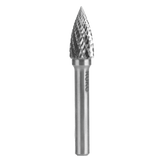What are Rotary Burrs?
Tungsten Carbide Rotary Burrs provide a maximum cutting performance, long service life and ease of use across the most popular materials. These tools give a smooth surface finish by removing sharp edges and excess material through the process of deburring.

Fitted to Air or Power Tools, they work by rotating at high speeds to grind away at or cut surfaces. This makes burrs suitable tools for shaping, grinding, cutting & removal of sharp corners and excess metal and plastic materials. Cross toothing provides excellent cutting capacity, reducing clogging and ensuring precise, effective, reliable results.
What is Tungsten Carbide?
A compound of Tungsten and Carbon, Tungsten Carbide (also abbreviated to TC) is a strong, dense and durable metallic material with a high melting point. This makes it a stronger compund compared to steel for cutting, deburring and drilling. TC is 3x more rigid than steel. Due to it long life and strong durability, it is considered one of the most valuable and capable forms of metal on the market. This makes it an ideal material for chipping, deburring and cutting excess material for Rotary and Grinder Tools.

End Toothing
Rotary Burrs with Toothing or End Cut allows for a maxium cutting performance suited for contour processes. With sharper edges to allow for more removal of excess material. Burrs without end toothing allow for a smoother finish and are much more suited to right angled corners.
 |
 |
| With End Toothing | Without End Toothing |
Shapes and Sizes Available
Rotary Burrs come with different shapes and sizes to allow for a variety of burring styles and scenarios. The different shapes allow for varying sharpness and angles to be used.
Cylinder (Shape A) - ZYA
This Burr is suitable for right angle corner cutting and surface milling.
Cylinder (Shape B) - ZYAS
This Burr is suitable for right angle corner cutting and surface milling.
Oval (Shape C) - WRC
This Burr is suitable for rounded contouring and end milling.
Ball Type (Shape D) - KUD
This Burr is suitable for rounded end milling and preparing for welding.
Tear Drop (Shape E) - TRE
This Burr is suitable for circular arc shaping and machining contouring.
Ball Nose Tree (Shape F) - RBF
This Burr has rounded and narrow features allowing multi-angle contouring.
Tree Shape (Shape G) - SPG
This Burr is suitable for multi-angle contouring into pointed and narrow places.
Flame Shape (Shape H) - FLH
This Burr features a round edge to allow round edge trimming, milling as well as preparing for welding.
Cone 60° (Shape J) - KSJ
This Burr features a cone shape with a 60° angle. This Burr allows for small scale cone shaped hole enlargements due to its burr shape and narrowness.
Cone 90° (Shape K) - KSK
This Burr features a cone shape with a 90° angle. This Burr allows for trimming of surface edges nicely due to the short height of the burr head.
Round Cone (Shape L) - KEL
This Burr with its rounded edges is suitable for accessing narrow places as well as cutting and surfacing round edges and enlarging holes.
Cone (Shape M) - SKM
This Burr with its rounded edges is suitable for accessing narrow places as well as cutting and surfacing edges and enlarging holes. It's sharp tip allows for a more direct precision point and target, as well as smaller diameters of enlargement of holes.
Angle (Shape N) - WKN
These shaped Rotary Burrs are ideal for v-cut deburring with its angled design.
Coating Choices Available
There are 3 common head/toothing coatings available for Tungsten Carbide Rotary Burrs. Each coating allows different levels of strength and smoothness against shaping material applications.
CT4 Tungsten Carbide (TC) Coating
This is the most common, sometimes considered the standard coating for Rotary Burrs. The high strength material of TC makes it suitable for metals such as: Steels (including Rust-Resistant Steels), Brass, Cast Iron and Titanium Alloyed.
ALU Aluminium Coating
Due to the nature of Aluminium Coated Rotary Burrs, they are ideal for tackling non-ferrous metals and similar softer materials. These include metals such as: Aluminium, Bronze, Silver, Gold, Nickel, Lead, Zinc and Copper. As well as this, ALU Coated Burrs are perfect for Plastic Materials.
TiCN Titanium Carbo-Nitride Coating
The TiCN wear-resistant coating increases the surface hardness of the tool to approximately 3,000 HV / micro-hardness and the heat resistance to 400° C. This increases service life and productivity. It is suitable for metals such as: Steels (including Rust-Resistant Steels), Brass, Cast Iron and Titanium Alloyed.
 |
 |
 |
| CT4 Coating | ALU Coating | TiCN Coating |
Typical Applications of Use
Due to Rotary Burrs being ideal for metalwork-based projects, alongside the size of the tools, they are particularly popular with jewellery fixing and making. They are also often used within metalwork related industries, such as engineering, welding, aerospace engineering, automotive, deburring, grinding, casting, milling, chamfering, metal and wood sculpturing and carving, model engineering, tool manufacturing and even in some cases dental industries.


Quality Tools UK offers a range of RUKO Rotary Burrs in different sizes and coatings. Feel free to view our collection here. Or contact us via one of the methods listed below for more information, help and support.
0 comments














